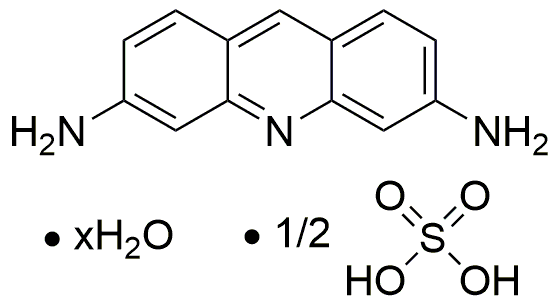Proflavine hemisulfate salt hydrate is widely utilized in research focused on:
- Antimicrobial Applications: This compound is effective against various bacteria and fungi, making it valuable in developing antiseptics and disinfectants for medical and laboratory use.
- Cell Culture Studies: Researchers use it to study cell behavior and interactions, particularly in cancer research, due to its ability to inhibit cell division.
- Genetic Research: It serves as a mutagen in genetic studies, helping scientists understand mutation processes and their implications in genetics.
- Histological Staining: Proflavine is employed in staining techniques to visualize cellular structures in tissue samples, aiding in pathological examinations.
- Antiseptic Formulations: Its properties allow for incorporation into topical antiseptics, providing a broad-spectrum antimicrobial effect for wound care and infection prevention.
Informations générales
Propriétés
Sécurité et réglementation
Applications
Proflavine hemisulfate salt hydrate is widely utilized in research focused on:
- Antimicrobial Applications: This compound is effective against various bacteria and fungi, making it valuable in developing antiseptics and disinfectants for medical and laboratory use.
- Cell Culture Studies: Researchers use it to study cell behavior and interactions, particularly in cancer research, due to its ability to inhibit cell division.
- Genetic Research: It serves as a mutagen in genetic studies, helping scientists understand mutation processes and their implications in genetics.
- Histological Staining: Proflavine is employed in staining techniques to visualize cellular structures in tissue samples, aiding in pathological examinations.
- Antiseptic Formulations: Its properties allow for incorporation into topical antiseptics, providing a broad-spectrum antimicrobial effect for wound care and infection prevention.
Documents
Fiches de données de sécurité (FDS)
La FDS fournit des informations de sécurité complètes sur la manipulation, le stockage et l’élimination du produit.
Spécifications du produit (PS)
Le PS fournit une description complète des propriétés du produit, notamment sa composition chimique, son état physique, sa pureté et les exigences de stockage. Il détaille également les plages de qualité acceptables et les applications prévues du produit.
Certificats d'analyse (COA)
Recherchez des certificats d'analyse (COA) en saisissant le numéro de lot du produit. Les numéros de lot et de lot se trouvent sur l'étiquette d'un produit, après les mots « Lot » ou « Lot de fabrication ».
Numéro de catalogue
Numéro de lot/série
Certificats d'origine (COO)
Ce certificat d'exploitation confirme le pays dans lequel le produit a été fabriqué, et détaille également les matériaux et composants utilisés et s'il est issu de sources naturelles, synthétiques ou autres sources spécifiques. Ce certificat peut être requis pour les douanes, le commerce et la conformité réglementaire.
Numéro de catalogue
Numéro de lot/série
Fiches de données de sécurité (FDS)
La FDS fournit des informations de sécurité complètes sur la manipulation, le stockage et l’élimination du produit.
DownloadSpécifications du produit (PS)
Le PS fournit une description complète des propriétés du produit, notamment sa composition chimique, son état physique, sa pureté et les exigences de stockage. Il détaille également les plages de qualité acceptables et les applications prévues du produit.
DownloadCertificats d'analyse (COA)
Recherchez des certificats d'analyse (COA) en saisissant le numéro de lot du produit. Les numéros de lot et de lot se trouvent sur l'étiquette d'un produit, après les mots « Lot » ou « Lot de fabrication ».
Numéro de catalogue
Numéro de lot/série
Certificats d'origine (COO)
Ce certificat d'exploitation confirme le pays dans lequel le produit a été fabriqué, et détaille également les matériaux et composants utilisés et s'il est issu de sources naturelles, synthétiques ou autres sources spécifiques. Ce certificat peut être requis pour les douanes, le commerce et la conformité réglementaire.


